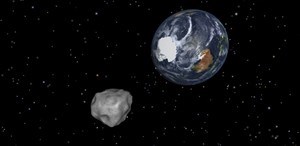
This image provided by NASA/JPL-Caltech shows a simulation of asteroid 2012 DA14 approaching from the south as it passes through the Earth-moon system on Feb. 15, 2013. THE CANADIAN PRESS/AP-NASA/JPL-Caltech
February 14, 2013 - 1:50 PM
MONTREAL - An asteroid about half the size of a football field will make a very close visit to Earth on Friday and will even be affected by the planet's gravitational pull.
Asteroid 2012 DA14 will pass inside the ring of satellites that circle the planet, but scientists say Canadians shouldn't be worried about a collision.
Peter Brown, a scientist at Western University in London, Ont., says it's the largest asteroid on record to pass so close to the Earth — 27,600 kilometres.
It is expected to pass over the Indian Ocean at around 2:30 p.m. EST.
"Things of this size get this close to the Earth or closer only about once every 40 years," Brown, who studies asteroids and meteors, said in an interview. ''So it's an unusual event."
The asteroid will come so close that the Earth's gravity will change its orbit, but it won't be dragged down.
"We know with absolute certainty it will not impact the Earth on Friday," Brown said. "And we can say that there's a very low chance — maybe one chance in 300,000 — that it will impact (the Earth) in the next 100 years or so."
Brown said the asteroid will be visible by binoculars in areas like Indonesia, eastern Europe, Asia and Australia, although it will be moving very fast.
It will be visible from North America later in the evening but only with high-powered telescopes.
NASA will provide coverage on its website, beginning at about 2 p.m. EST.
Asteroid 2012 DA14 is the same size as a space boulder that exploded over a wooded area in Siberia in 1908 in what became known as the Tunguska event. About 2,000 square kilometres of trees were flattened in an uninhabited area.
"It was not detected before impact," Brown added. "Although with the current telescopic surveys that are going on, there's a reasonable chance that an object like Tunguska could be detected before it impacted the Earth."
Brown also pointed out that scientists have become better at understanding and documenting the orbits of potentially dangerous asteroids.
"There are about 1,000 asteroids that get fairly close to the Earth and cross the Earth's orbit that are one-kilometre in size," Brown said, adding the orbits of 90 per cent of them are known.
"So we can say with definitiveness that of all the ones that we have accurate orbital data for, none of them are going to hit in the next 100 years."
Alan Hildebrand of the University of Calgary says studies are already being done to see how a threatening asteroid can be deflected.
"People have talked of many different concepts for moving or diverting asteroids," the planetary scientist said in an interview.
One option would involve exploding a device near an asteroid while another would use a spacecraft to pull it away.
"Some people would say you fly a spacecraft alongside and just the mass of the spacecraft will pull it — that's the gravity tractor idea," he said.
There's also the notion of using lasers or an ion beam to vaporize some of the surface of an asteroid.
Hildebrand will get a chance to take a closer look at asteroids when NEOSSat, a Canadian satellite, blasts off from India on Feb. 25. He's one of the project's principal investigators.
NEOSSat (Near Earth Object Surveillance Satellite) will circle the globe every 100 minutes and scan areas near the sun to pinpoint as yet undetected asteroids.
The $15-million suitcase-sized satellite, which will circle about 800 kilometres above the Earth, is the first dedicated space telescope to look for potentially hazardous asteroids.
"Our prime science mission is to search for the population of asteroids that orbit mostly inside Earth's orbit or entirely inside Earth's orbit," Hildebrand said.
"We're looking in the sky near the sun which is hard to do from the ground (and) we'll be filling in a part of orbital space which is poorly known so far."
News from © The Canadian Press, 2013